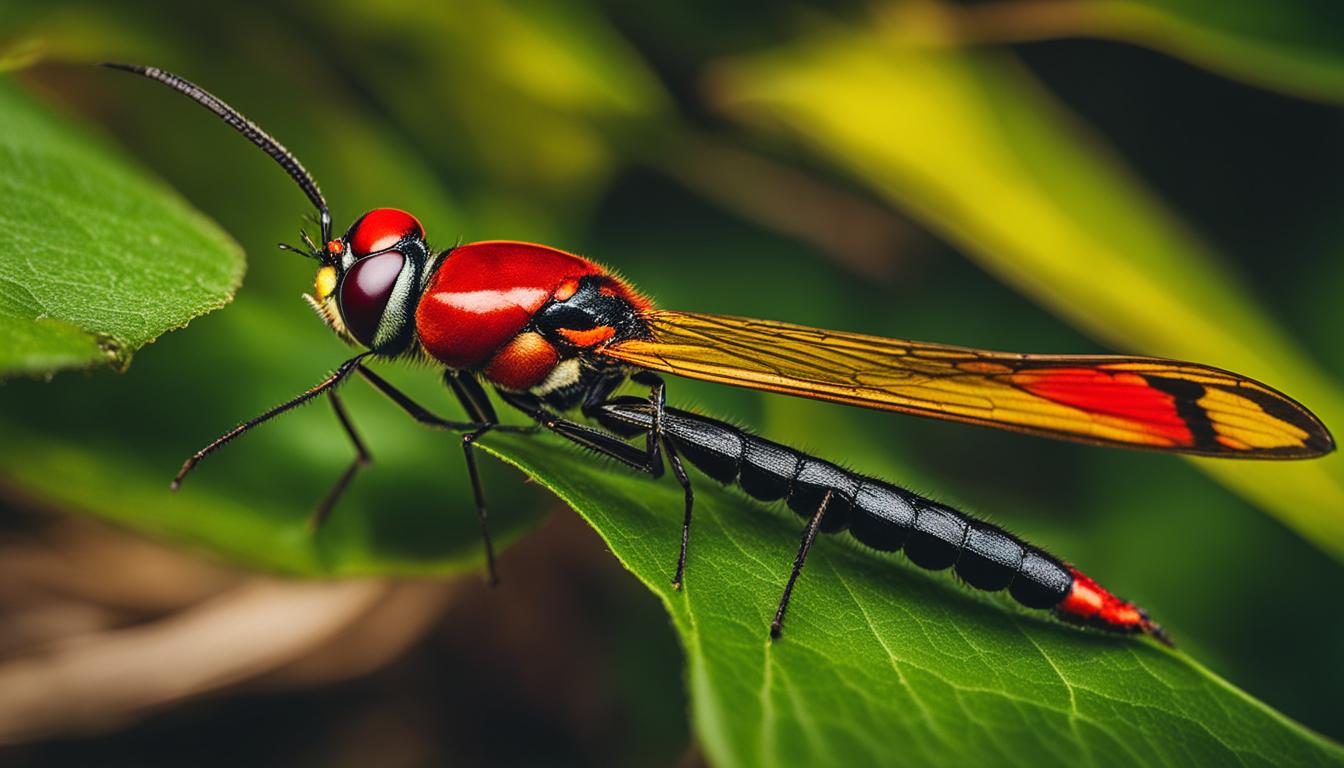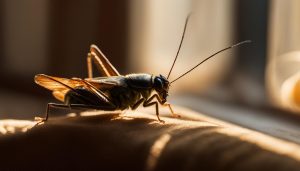Insects have long held a place in our traditional beliefs and superstitions. From ladybugs to dragonflies, these tiny creatures have fascinated and intrigued cultures around the world. In this article, we explore the insect that is traditionally considered good luck by many.
Contents
- 1 The Myth of Lucky Ladybugs
- 2 The Luck of the Crickets
- 3 The Symbolic Dragonflies
- 4 Butterflies and Their Transformative Symbolism
- 5 Bugs Bring Luck, but Pest Control is Necessary
- 6 Conclusion
- 7 FAQ
- 7.1 Why are ladybugs considered lucky?
- 7.2 Are crickets considered lucky in any culture?
- 7.3 What do dragonflies symbolize?
- 7.4 What did scarab beetles symbolize in ancient Egypt?
- 7.5 What do butterflies represent?
- 7.6 Are all bugs considered lucky?
- 7.7 Why are insects believed to bring luck?
- 7.8 What is the significance of bug superstitions?
- 8 Source Links
Key Takeaways:
- Ladybugs are believed to bring good luck and happiness. Killing a ladybug is considered bad luck.
- Crickets are seen as a symbol of luck in many Asian cultures. Killing a cricket is believed to bring years of bad luck.
- Dragonflies represent change and subconscious dreams. They are associated with traits such as prosperity and peace.
- Scarabs held great significance in ancient Egypt and symbolized protection and transformation.
- Butterflies are associated with transformation and inspiration, representing the beauty of life.
The Myth of Lucky Ladybugs
In many cultures, ladybugs are believed to bring good luck and are considered a symbol of fortune. These bug superstitions have been passed down through generations, and people often seek out these little creatures for their positive energy. Ladybugs are also associated with love, happiness, and counting the spots on their back is thought to predict good fortune. Some individuals even wear ladybug amulets as good luck charms.
The belief in the luck of ladybugs is deeply ingrained in cultural beliefs and traditions. However, it’s important to note that killing a ladybug is considered bad luck in many superstitions. So, if you come across a ladybug, it’s best to admire its beauty and let it go on its way, rather than harm it.
In Asian cultures, ladybugs are also seen as a symbol of protection against pests and crops. They are known to eat destructive pests like aphids, making them beneficial insects in gardens and agricultural fields. Ladybugs are often used in pest control management to help maintain a healthy balance in the ecosystem without the need for harmful pesticides.
So, the next time you spot a ladybug, remember its significance in bug superstitions and the positive energy it symbolizes. Embrace the luck it brings and let it inspire you to appreciate the small wonders of nature.
| Beliefs | Cultural Associations | Symbolism |
|---|---|---|
| Ladybugs bring good luck | Love, happiness, protection | Counting spots predicts good fortune |
| Killing a ladybug is bad luck | Asian cultures associate with pest control | Wearing ladybug amulets as good luck charms |
The Power of Ladybug Amulets
Ladybug amulets are worn by many individuals who believe in their ability to attract good luck and positive energy. These amulets often feature ladybug designs and are commonly made of materials like silver or gold. By wearing a ladybug amulet, it is believed that you carry the luck and protective qualities of the ladybug with you wherever you go.
“Ladybug amulets are not only fashionable accessories, but they also hold spiritual significance. They serve as a reminder to embrace the positive energy and good fortune that the ladybug symbolizes.” – Spiritual Beliefs Magazine
Whether you believe in bug superstitions or not, there’s no denying the charm and beauty of these little insects. Ladybugs continue to captivate our imagination and remind us of the wonders of the natural world. So, next time you spot a ladybug, take a moment to appreciate its presence and perhaps even make a wish for a little extra luck.
The Luck of the Crickets
In many Asian cultures, crickets have long been considered a symbol of luck. These small insects are believed to bring good fortune and prosperity to those who encounter them. One of the reasons crickets are seen as lucky is their ability to sense danger. They have been known to stop chirping when danger is near, acting as “watchdogs” in the home. This unique behavior has led to the belief that having crickets in the house can protect against harm and bring years of good luck.
Cricket superstitions in Asian cultures go beyond their association with luck. In some countries, such as China and Japan, crickets are also seen as a symbol of wealth and success. They are often kept as pets and revered for their melodious chirping. It is believed that the pleasant sound of crickets can bring harmony and peace into a person’s life.
Cricket Superstitions in Asian Cultures:
- Cricket chirping is associated with good luck and prosperity.
- Keeping crickets in the home is believed to bring protection against harm.
- Cricket chirping is seen as a symbol of wealth and success.
- Crickets are considered a source of harmony and peace.
Whether you personally believe in cricket superstitions or not, their significance in Asian cultures cannot be denied. The perception of crickets as lucky creatures has been passed down through generations, shaping cultural beliefs and traditions. So, the next time you hear a cricket’s chirp, take a moment to appreciate the potential for luck and positive energy they bring.
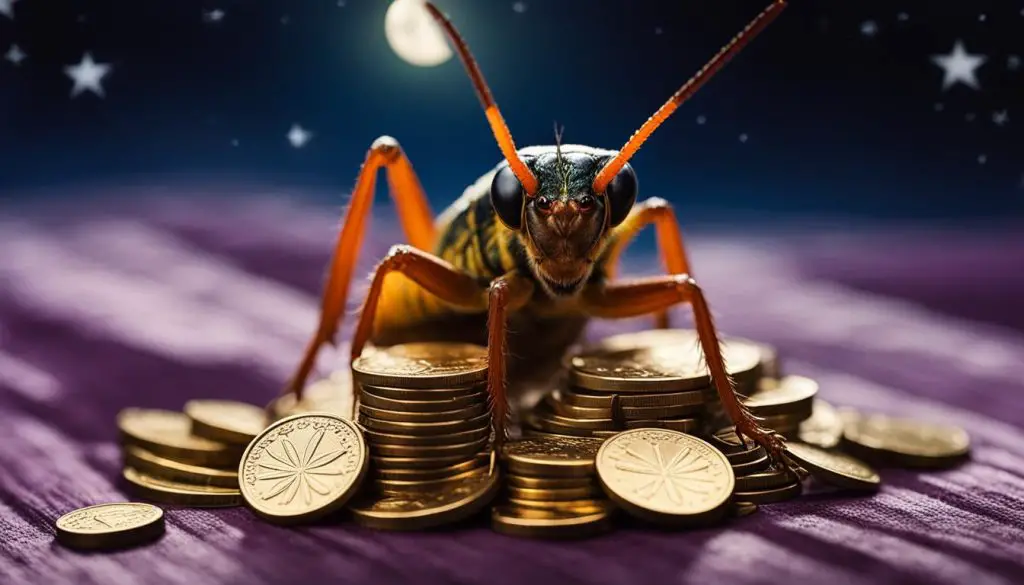
| Country | Belief |
|---|---|
| China | Keeping crickets in the home brings wealth and success. |
| Japan | Cricket chirping is associated with harmony and peace. |
| India | Crickets are seen as a symbol of fertility and abundance. |
The Symbolic Dragonflies
Dragonflies hold deep symbolic meaning in various cultures around the world. These enchanting creatures are associated with change, subconscious dreams, and cultural significance. Their unique characteristics and symbolism make them an intriguing subject of fascination and admiration.
In many ancient cultures, dragonflies were seen as symbols of transformation and change. The dragonfly’s life cycle, which involves a dramatic metamorphosis from a water-dwelling nymph to a graceful airborne insect, embodies the concept of transformation. Their ability to gracefully navigate through different stages of life serves as a powerful metaphor for personal growth and adaptation.
Dragonflies also hold symbolic meaning in the realm of dreams and the subconscious. In some cultures, it is believed that dragonflies can bring messages from the spiritual realm or act as guides during dream journeys. Their appearance in dreams is often seen as a sign of personal transformation or a message to pay closer attention to one’s thoughts and emotions.
“The dragonfly symbolizes change and the power of the self-realization journey. It teaches us to embrace growth and transformation, reminding us of the beauty that can be found in the process of change.” – Unknown
Furthermore, dragonflies carry cultural significance in various societies. In Japan, they are associated with strength, courage, and victory. In Native American folklore, dragonflies are seen as a symbol of harmony, joy, and purity. The intricate patterns on their wings are often admired for their beauty and delicate nature.
The Cultural Significance of Dragonflies
Dragonflies hold cultural significance in many societies:
| Country | Symbolism |
|---|---|
| Japan | Strength, courage, victory |
| Native American | Harmony, joy, purity |
| China | Prosperity, harmony, good luck |
| Sweden | Lightness, freedom, and joy |
Dragonflies continue to captivate our imagination with their ethereal beauty and profound symbolism. Whether as a representation of personal growth, a messenger from the spiritual realm, or a symbol of cultural significance, these enchanting insects remind us of the power of change and the beauty that lies within the natural world.
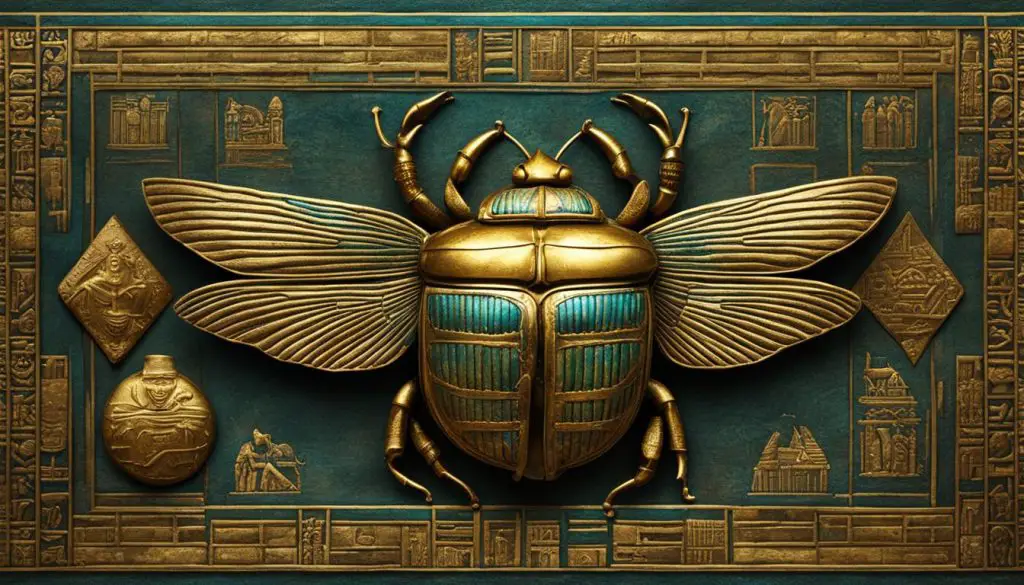
“The scarab was one of the most popular symbols in ancient Egypt, representing protection and transformation. It was a powerful symbol that encompassed the profound beliefs and values of the ancient Egyptians.” – Egyptologist
Butterflies and Their Transformative Symbolism
Butterflies are fascinating creatures that have captivated human imagination for centuries. Their delicate wings and graceful flight make them a symbol of beauty and transformation. In many cultures, butterflies hold deep symbolic meanings and inspire people to embrace change and pursue their dreams.
The Symbolism of Butterflies
Butterflies symbolize transformation and the journey of life. Just like a caterpillar undergoes a remarkable metamorphosis to become a butterfly, the symbolism of butterflies encourages us to embrace change and grow into our fullest potential. The process of transformation can be challenging, but it also holds the promise of beauty and freedom.
Moreover, butterflies inspire us to embrace our individuality and uniqueness. Each butterfly carries a distinct pattern on its wings, reminding us that we are all special in our own way. They encourage us to express ourselves authentically and celebrate our true colors.
Inspiration and Life Lessons
Observing butterflies can be a source of inspiration and life lessons. Their ability to gracefully navigate the winds and adapt to different environments teaches us the importance of flexibility and resilience. They remind us to let go of fear and embrace life’s uncertainties with grace and optimism.
Butterflies also symbolize the ephemeral nature of life. Their lifespan may be short, but their impact on the world is profound. They remind us to cherish each moment, appreciate the beauty around us, and make the most of our time on Earth.
Table: Symbolic Meanings of Butterflies in Different Cultures
| Culture | Symbolic Meaning of Butterflies |
|---|---|
| Native American | Transformation, rebirth, and renewal |
| Chinese | Love, joy, and marital bliss |
| Japanese | Transformation, beauty, and grace |
| Greek | Soul, immortality, and the human psyche |
| African | Freedom, joy, and the power of dreams |
Whether you encounter a butterfly in a garden, see it delicately perched on a flower, or witness its fluttering flight, take a moment to appreciate the profound symbolism and lessons it carries. Let butterflies inspire you to embrace change, discover your true self, and live a life filled with beauty and purpose.
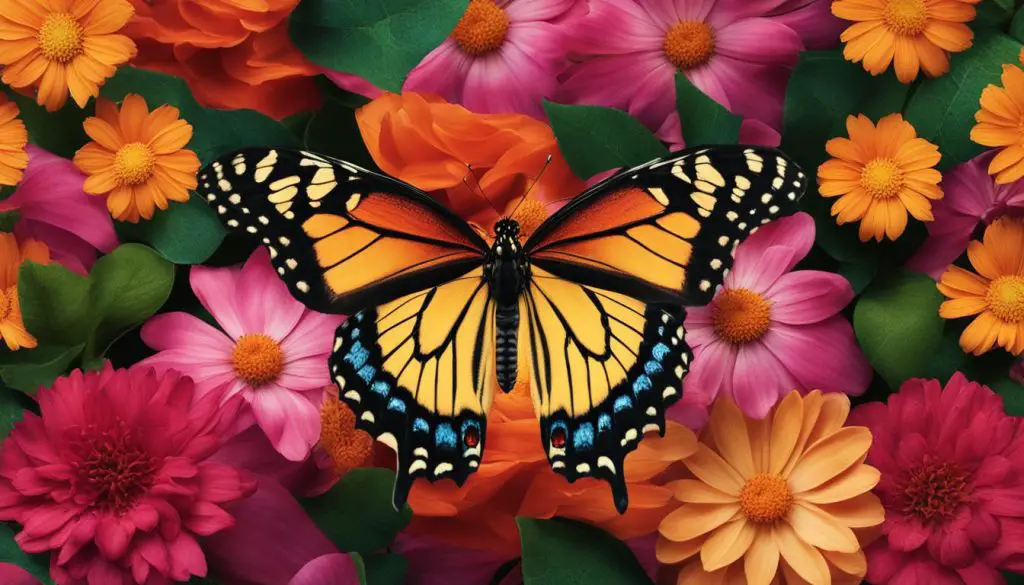
Bugs Bring Luck, but Pest Control is Necessary
While bugs have long been associated with luck and symbolic meanings, it’s important to recognize that not all insects are considered fortunate. In fact, many bugs can cause significant problems in our homes. That’s where pest control comes in.
Pest control is essential for dealing with infestations and maintaining a pest-free environment. Whether it’s ants, cockroaches, or termites, these home pests can damage property, contaminate food, and pose health risks. Effective pest management techniques can help eliminate these unwanted visitors and ensure a healthy living space for you and your family.
But what about the bugs that are traditionally considered lucky? Ladybugs, for example, are seen as a symbol of good luck in many cultures. They are believed to bring patience, happiness, and even take away illness. Ladybugs can also be beneficial in pest control themselves, as they feed on harmful insects like mealybugs.
So, while some bugs may bring luck, it’s important to strike a balance. Embrace the positive symbolism of lucky bugs while also taking the necessary steps to manage and control pests. By doing so, you can maintain a healthy and harmonious environment in your home.
| Lucky Bugs | Pest Control Challenges |
|---|---|
| Ladybugs | – Beneficial for pest control, prey on harmful insects – Considered lucky in many cultures |
| Cricket | – Considered lucky in Asian cultures – Can be problematic if present in large numbers |
| Dragonflies | – Symbolize change and subconscious dreams – Not typically associated with pest problems |
| Scarabs | – Held great significance in ancient Egypt – Not present as pests in modern homes |
| Butterflies | – Symbolize transformation and inspiration – Not considered home pests |
By understanding the importance of pest control and implementing effective management techniques, you can create a balanced and luck-filled environment in your home. So, embrace the lucky bugs while keeping unwanted pests at bay!
“Remember, luck favors those who take care of their homes and protect against pests!”
Conclusion
Throughout history and across cultures, insects have played a significant role in shaping our beliefs and superstitions. From ladybugs to crickets, dragonflies to scarabs, and butterflies to many more, these small creatures have been considered lucky and held symbolic meanings in various traditions.
These bug superstitions highlight the cultural beliefs and the deep-rooted connection between humans and the natural world. The lucky insects that we encounter in our everyday lives remind us of the awe-inspiring wonders of nature and the intricate web of symbolism that surrounds us.
While bug superstitions bring a touch of magic and curiosity to our lives, it’s important to remember that pests can also be a nuisance. Proper pest control and management are crucial to maintaining a healthy and pest-free home environment. By understanding the significance of these symbolic insects and implementing effective pest management techniques, we can strike a balance between embracing cultural beliefs and ensuring our well-being.
So, the next time you spot a ladybug, hear the chirping of a cricket, or catch a glimpse of a dragonfly, take a moment to appreciate the lucky insects and the rich cultural tapestry they are a part of. Embrace the stories, beliefs, and symbolic meanings that have been passed down through generations, and continue to cherish the fascinating world of bug superstitions.
FAQ
Why are ladybugs considered lucky?
Ladybugs are believed to bring good luck because they are associated with patience, happiness, and the ability to take away illness. Killing a ladybug is considered bad luck.
Are crickets considered lucky in any culture?
Yes, in many Asian cultures, crickets are considered symbols of luck. Their chirping was thought to stop when danger approached, so they were kept in homes as “watchdogs.” Killing a cricket, even accidentally, is believed to bring years of bad luck.
What do dragonflies symbolize?
Dragonflies symbolize change, subconscious dreams, prosperity, strength, peace, purity, courage, and harmony. The sighting of a dragonfly is often believed to indicate an upcoming change in one’s life.
What did scarab beetles symbolize in ancient Egypt?
Scarab beetles held great significance in ancient Egypt. They symbolized the rising sun and were seen as protection against evil. Scarabs were also associated with transformation, regeneration, and rebirth.
What do butterflies represent?
Butterflies are associated with transformation and inspiration. They symbolize the process of metamorphosis and represent strength, vitality, and the beauty of life.
Are all bugs considered lucky?
No, not all bugs are considered lucky. Ladybugs are seen as lucky, but other pests can cause problems in the home. Pest control is necessary to deal with infestations and maintain a healthy environment. Pest management techniques, such as using ladybugs for mealybug control, can help without the need for harmful pesticides.
Why are insects believed to bring luck?
Throughout history and across cultures, insects have been associated with luck and symbolic meanings. Ladybugs, crickets, dragonflies, scarabs, and butterflies are just a few examples of insects that have been considered lucky and significant in various traditions. These beliefs highlight the cultural significance and symbolic importance of insects in folklore.
What is the significance of bug superstitions?
Bug superstitions reflect the human desire for luck and protection against negative forces. They also provide a window into cultural beliefs and traditions surrounding insects. Bug superstitions have been passed down through generations, shaping the way people perceive and interact with these creatures.

